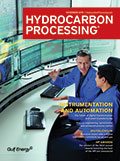
November 2019
Special Focus: Instrumentation and Automation
In today’s challenging oil and gas operations, it is vital to have a robust operating system that supports each facility’s goal of operational excellence (OE). Digital transformation and smart manufacturing are being implemented by Saudi Aramco as a coined umbrella term: integrated manufacturing operations management system (imoms).
Two of the terms growing in popularity over the past few years are “digital native” and “digital immigrant.” Natives are those individuals young enough to have known computers and the internet since childhood. For them, such technologies have always existed. Immigrants, either through age or circumstance, had no exposure until later in life. Hopefully, for them, such technologies are a welcome addition to work and life, but they can remember times when most activities were more manual, local and isolated.
A recent <i>Hydrocarbon Processing</i> “Industry Perspectives” survey found that process engineering and optimization is the number-one topic that readers want to read about most. Process engineering and optimization rated higher than the next-highest topic (maintenance and reliability) by a factor of 2:1, and higher than every other topic by a factor of at least 4:1. Process control and instrumentation made the top ten list, albeit below process engineering and optimization by a factor of 7:1.
In 1864, James C. Maxwell predicted the existence of radiowaves by means of a mathematical model. The so-called Maxwell equations are the most famous and successful formulas. In 1884, John H. Poynting realized that the Poynting vector would play an important role in quantifying electromagnetic energy. In 1888, bolstered by Maxwell’s theory, Heinrich Hertz first succeeded in showing experimental evidence of radiowaves using his spark-gap radio transmitter. The prediction and evidence of radiowaves were the beginning of wireless power transfer (WPT).
Cybersecurity
The need for a solid cybersecurity strategy has been discussed and debated for nearly half a century. However, the basic worm-type attacks first documented in 1972 are still with us today. Why? The reason is because even the most basic measures to protect control systems from these types of attacks are still not systematically employed.
Hydrocarbon Processing Awards
<i>Hydrocarbon Processing,</i> the downstream processing sector’s leading technical publication, has announced the winners for its third annual awards. The <i>HP</i> Awards celebrate innovative technologies and people that have been instrumental in improving facility operations over the past year.
Catalyst
In 2010, a JV embarked on the deployment of a MHY zeolite technologyb developed at the Massachusetts Institute of Technology. This novel zeolite technology improves traditional zeolite catalysts through the introduction of highly interconnected channels of medium pore size, which enhance diffusion of feed molecules inside zeolite crystals, leading to higher-value product yields, improved process efficiency and increased refinery profitability.
The fluid catalytic cracking unit (FCCU) is a conversion unit located at the heart of many refineries. Its main purpose is to crack crude oil-derived feedstocks into valuable liquid products, primarily LPGs (propylene and butylenes), and gasoline and light-cycle oil (LCO) precursors. The process uses a fluidizable catalyst, comprising an alumina-silica framework and tailored for each refinery to meet its specific needs. Often, the changing of a catalyst includes catalyst testing evaluations, employed by about 50% of the FCCUs in the world. The testing process is cumbersome, in which multiple methods are available to refineries.
Process Optimization
Phase equilibrium properties, such as bubble point, hydrocarbon dewpoint, water dewpoint, phase envelope, two-phase compositions, compressibility factor, hydrate equilibrium properties, etc., for hydrocarbon mixtures have been calculated accurately using the Peng-Robinson cubic equation of state by implementing constant and temperature-dependent binary interaction parameters in the Van der Waals mixing rule.
Sustainability
Bio-based, renewable fuels and chemicals can reduce the environmental footprint of maintaining global transportation and product demands, while also offering supplementation of traditional fossil fuels in a global environment with increasing energy demand. The renewable energy sector is large and growing rapidly.
Sustainability is emerging as a critical business topic, as many companies focus resources toward lowering emissions, waste and energy use in their production processes. This important concept can apply broadly to company operations, especially when considering the expansive view of the triple bottom line that measures the impact of company operations on profits, people and the planet.
Environment and Safety
In the production of clean fuels, plastics and other hydrocarbon-based products, refineries and petrochemical facilities generate unwanted (waste) byproducts. Having no market value, the undesired byproducts must be recycled, minimized or eliminated. Depending on the feedstocks, end products and reactant materials, the unwanted materials can be gases, liquids or multiphase materials.
Valves, Pumps and Turbomachinery
Ball valves are often an economical solution for controlling flows in refinery high-temperature applications, but their application can be complex, particularly in high-temperature uses.
Water Management
Water is key to the hydrocarbon processing and chemical processing industries. Yet, it is not an infinite resource, which creates operational, financial and regulatory risks. The true cost of water can include insurance and litigation costs and disposal costs, plus the capital expenditures (CAPEX) and operating expenses (OPEX) of water infrastructure.
Refineries consume large amounts of energy and water to refine crude oil into products. Up to 10% of crude oil’s energy content is consumed during processing, and it takes 1.5 bbl of water to process one barrel of crude oil. Refining processes also generate large quantities of excess thermal energy that needs to be expelled into the environment using a once-through or recirculating cooling system.
Columns
Due to Tropical Storm Imelda, Hydrocarbon Processing issued its first force majeure in postponing the third annual HP Awards.
Shock pulse technology is generally well known to vibration analysts and reliability technicians. A handheld combination of sensor and display meter would typically be used to detect discontinuities in bearings and would respond to the impact of two masses. The resulting shockwaves will create a shock pulse of a certain magnitude that commonly manifests itself at a particular repeat frequency. The respective magnitude of relevant excursions and their trends can be observed by the person entrusted with the monitoring task.
Traditionally, conversations around automation and safety have focused largely on logic solvers and instrumentation. However, new disruptive technologies and a rapid expansion in networking and computing resources have broadened the scope of automation’s reach. These transformative technologies and approaches promise to reduce incidents and increase production in ways industry could only imagine in the past; but while the “pieces” are available, organizational silos and entrenched cultures stand in the way.
Guyed structures are common in petrochemicals, oil and gas and chemical industries. Half of the installed flare structures at many facilities are guyed. Various routine inspection programs are in place to examine these structures. This work describes some very basic checks, which should be in place to maintain their mechanical integrity.
Oil and gas companies have realized big cost savings over the years by having suppliers source all elements of the electrical control system in a fully integrated package. However, this methodology fell short of delivering the kind of insights and efficiencies that companies expect and require in oil and gas operations today.
Oil and gas investments are diversifying as the industry leans toward a more digitally conducive environment. Asset analysis was initially evaluated based on an asset’s technical parameters, pricing and operationality. In this new digital world, however, variables such as service quality, innovation, compliance, flexibility and scalability require quantification. Refinery data continues to be critical to evaluate investments, but is often incomplete.
Trends and Resources
The nominees for the 2019 Top Project awards are out. Using <i>Hydrocarbon Processing’s</i> Construction Boxscore Database, the editors have identified nine projects that are anticipated to significantly impact the global or regional downstream industries.
Total plans to take a final investment decision (FID) on the Nigeria LNG expansion project by the end of this year. If greenlighted, the 7-MMtpy LNG train would increase the Bonny Island LNG terminal’s capacity to nearly 30 MMtpy. If built, Train 7 is expected to be operational by 2023.

- Phillips 66 Limited agrees to acquire Lindsey Oil Refinery assets 1/5
- IIT Guwahati (India) develops sunlight-driven catalyst to convert carbon dioxide into methanol fuel 1/5
- PBF Energy provided an update on efforts to rebuild its Martinez refinery 1/5
- Tasnee's Saudi Ethylene and Polyethylene Co. commences planned maintenance of ethylene plant 1/2
- Advanced Biofuels Canada Association welcomes federal biofuels production incentive coming into force 1/2
- Technip Energies completes acquisition of Ecovyst’s Advanced Materials & Catalysts business 1/2




